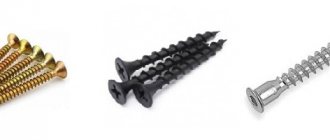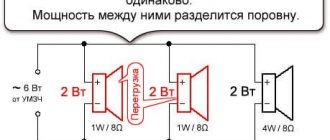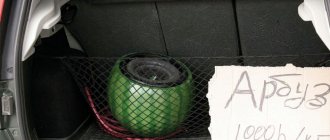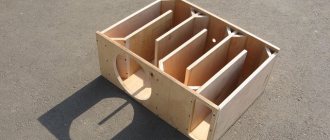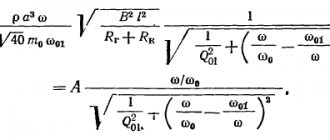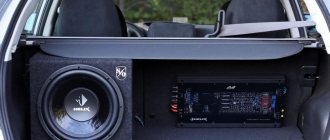Our next job, this time we designed a box for two Ural Molot 12 subwoofers. These speakers are reluctant to reproduce low bass, of course, you can greatly increase the net volume as we did here. But as a result, for stable operation it is necessary to limit the supplied power.
This time we did not make a large volume. The subwoofer has a hard and fast bass, which is perfect for fans of rhythmic music with high bass, for example, rock, dnb, pop. Due to the clamped volume, the frequency response shows that a small hump appears in the region of 45 Hz.
But it’s difficult to say that the subwoofer only plays high bass.
Box detailing
| 1 | 365 x 403 | 1 |
| 2 | 365 x 868 | 1 |
| 3 | 365 x 385 | 1 |
| 4 | 365 x 768 | 1 |
| 5 | 365 x 303 | 1 |
| 6 | 365 x 251 | 1 |
| 7 | 365 x 72 | 3 |
| 8 | 365 x 72 | 1 |
| 9 | 868 x 421 | 2 |
Box characteristics
1 Ural Molot 12
| 2 | 40 Hz |
| 3 | 90 l |
| 4 | 146.5 l |
| 5 | 300 cm cube |
| 6 | 58.91 cm |
| 7 | |
| 8 | 421 x 868 x 401 |
| 9 |
Recommended amplifier settings
*PHASE – smooth phase adjustment. There is such an effect as a temporary lag of the subwoofer bass from the rest of the music. However, by adjusting the phase this phenomenon can be reduced.
Before installing the amplifier, read the instructions, in it you will find what cross-section of the power wire is necessary for stable operation of your amplifier, use only copper wires, monitor the reliability of the contacts, as well as the voltage of the on-board network. Here we have described in detail how to connect the amplifier.
Frequency response box
Frequency response – graph of amplitude-frequency response. It clearly demonstrates the dependence of loudness (dB) on sound frequency (Hz). From which you can imagine how our calculation will sound when installed in a sedan car.
We hope that in this article you found answers to your questions. Rate how useful this article was to you? Below you can rate it from 1 to 5 stars. If you have any questions or questions, please leave them in this article by filling out the form below. We will give a qualified answer to it. Your opinions, questions and comments are very important to us.
Car subwoofers use different types of loudspeakers. They differ in power, frequency range and voice coil resistance.
Low-frequency loudspeakers use speakers with winding resistances of 4, 2 and 1 ohms.
In addition to speakers with one speaker, in practice, acoustic systems with two loudspeakers or speakers with two windings are often used. Each LF system has its own connection features.
Connecting a subwoofer 2 X 2
Low-frequency systems with two loudspeakers are often installed in cars. They provide great power, deep and rich bass. The connection diagram for a 2 X 2 subwoofer may differ from other options. This design can be made in the form of a closed box or work with a bass reflex.
Connecting a 2 X 2 subwoofer can be done in two simple ways. This is a series or parallel connection of loudspeaker voice coils. In order to calculate the resulting resistance, a simple formula is used. The voice coil winding is a low-resistance resistor.
When two 2 Ohm coils are connected in series, the total resistance is 4 Ohms, based on the formula R total=R1+R2 or 2 Ω+ 2 Ω=4 Ω.
The connection diagram for a 2 X 2 subwoofer at 4 Ohms does not cause any difficulties, since almost all low-frequency amplifiers operate with such a load. The formula for parallel connection of resistances looks a little different.
Here the resulting resistance of several resistors will be less than the smallest resistance of the parallel circuit. According to the formula Rtotal=R1*R2/R1+R2, the resistance of two 2 Ω coils connected in parallel will be equal to 1 Ω.
Connecting a 2 X 2 in 1 subwoofer is associated with some difficulties, since not all models of low-frequency amplifiers can work correctly with such a load impedance. Each connection has its own specifics.
If in the subwoofer connection diagram there are 2 X 2, the windings of the voice coils are connected in series, then the power will decrease by about half. Since one speaker with an impedance of 2 provides a nominal power of 500 watts, connecting a second speaker in parallel with the same impedance will reduce the system output power to 350 watts.
How to connect a 1 ohm subwoofer
The subwoofer connection diagram in 1 ensures maximum power from the low-frequency unit and the highest volume level. However, the quality of bass reproduction will not be the best. Low frequencies will be “smeared out”. As the load resistance of the amplifier increases, the power will decrease, but the quality of low-frequency reproduction will noticeably increase. The blurriness of the sound will disappear, and the bass will become clear and deep. You cannot connect a 1 Ω subwoofer to every amplifier model. The description of some low-frequency units specifically stipulates the minimum permissible load resistance. Loudspeakers with a 1 Ω coil are rare, so this resistance is usually obtained by connecting two 2 speakers in parallel. Connecting a 2 X 2 in 1 Ohm subwoofer can be done by using one speaker with two 2 Ω windings. They always indicate the polarity. In order for the speaker system to work correctly, you need to connect the speaker contacts correctly.
The pros and cons of the voice coils are interconnected and connected to the corresponding contacts of the low-frequency amplifier.
How to connect a 4 ohm sub
Connecting a subwoofer at 4 is considered the most common, since most dynamic heads have such resistance, and all types of low-frequency amplifiers allow the use of such speakers as a load. You can organize a 4 ohm load using two 2 ohm speakers connected in series, when the plus of one speaker is connected to the minus of the other. The connection diagram for a subwoofer in 4 can be obtained using a two-winding speaker. Depending on their resistance, the connection configuration depends. Two coils of 8 connected in parallel will give, as a result, the required 4 Ohms. The same resistance is obtained if two voice coils with a resistance of 2 ohms are connected in series.
Purpose and use
In a certain context, this device can be compared to an analog-type sound processor. Now that the purpose is clear, let’s now look at the design, operating principle and calculations. The proposed solution is especially in demand among motorists who want to install high-quality sound on used cars; with some effort, it will not be inferior to expensive audio systems.
So, in the technical understanding, the FM box, as implied by the name, is a resonator. We are talking about a hollow structure with the help of which sounds of a given frequency are reproduced. One of the functions of the resonator is to enhance audio sound. Such a device in the car will allow you to listen to loud music, provide musical accompaniment in nature, or use it for commercial purposes, for example, for scoring weddings and celebrations. The most popular solution is a box for a 12-inch speaker.
Box detailing
The size and number of parts for building the box, i.e. you can give the drawing to a company that provides wood cutting services (furniture), and after a certain time pick up the finished parts. Or you can save money and make the cut yourself. The dimensions of the parts are as follows:
We also have calculations for two Ural molot 12 subwoofers
Box characteristics
Frequency response box
This graph shows how the box will behave in a medium-sized sedan, but in practice small deviations are possible since each sedan has its own interior characteristics.
We are sure that you will be satisfied with the result, you can find a large number of answers to questions in the subwoofers section, and you can also ask us a question by filling out the form below. This will help us make our portal even better and more informational.
Sources used:
- https://caraudioinfo.ru/chertezhi/korob-dva-molot-12.html
- https://dinamikservis.ru/blog/sabvufery/podklyuchenie-saba-2×2-4×4-1-om/
- https://caraudioinfo.ru/chertezhi/korob-dlya-sabvufera-ural-molot-12-38hz.html
Drawing of a box for a 12-inch subwoofer
For regular background listening to music or PC sounds, 2 small desktop speakers are enough, but for movies or games you want more powerful bass. Then the idea was born to create a small 12″ subwoofer that would enrich a computer gaming system. It is based on the STX 27-150-4-SC speaker.
Subwoofer housing
The box is a 50 liter bass reflex tuned to 35 Hz and is made from 18mm chipboard glued and reinforced with screws. External dimensions:
- height 45 cm,
- width 41.5 cm,
- depth 35 cm,
- tunnel diameter with bass reflex 8 cm,
- length 5 cm.
The damping polyurethane sponge (except for the front one) is glued to the body with a glue gun. The cladding was covered with batren-based glue; the glue must be processed by both the veneer and the shell.
First the veneer was laid on the back after drying, it was sanded down to the edge of the casing, then the veneer was glued to the side and then to the bottom and top and finally to the front (each side flush with the edge of the casing), at the end the holes were cut so that they matched with those that were previously cut out for the loudspeaker, bass reflex and connection terminals.
The result of the work was soldering the wires and screwing the speaker, terminals and gluing the bass reflector (transparent polyester is recommended).
Connecting a subwoofer
The subwoofer is powered by TDA7294 with an AC voltage of 30 V, that is, +/-42 V DC. Yes, and the UMZCH on LM3886 is suitable for this subwoofer, and the power depends on the load and voltage, if you supply +/- 35 V, theoretically reach 100 W. Here are the parameters with this chip:
Useful: Circuit for detecting zero in a 220V network
- Maximum supply voltage:
- Recommended voltage range: 20 … 84 V (± 10 … ± 42 V) No signal: 94 V (± 47 V) during operation: 84 V (± 42 V)
- Quiescent current: typ 50mA, max 85mA
How to make a stealth subwoofer with your own hands
Having considered how to make a box with your own hands, it should be noted that the owner does not always intend to install a large box in the trunk. For this reason, many car enthusiasts are interested in how to make a stealth subwoofer with their own hands.
It is well known that a stealth subwoofer is practical, does not take up much space and is often a factory solution on cars where a subwoofer is used in the speaker system.
Let us immediately note that making and installing a stealth subwoofer with high quality is more difficult and more expensive than a regular box. If only this option is needed, then for manufacturing and installation you will need:
- woofer;
- grill grate for protection;
- socket for connecting to an amplifier;
- wire for connecting the woofer to the outlet;
- Chipboard or multilayer plywood (thickness 2 cm);
- some fiberboard, epoxy glue, fiberglass;
- wood screws, mounting tape and plastic film;
- tools you need are a screwdriver, a drill, a jigsaw and a brush;
Having decided on the installation location, you need to unload the trunk, remove the trunk trim at the subwoofer installation site in order to be able to install the subwoofer as close as possible to the car fender.
At the initial stage, you need to lay a plastic film on the floor in the trunk to protect the inner lining from epoxy glue and to implement a fastening for screwing the back wall of the sub. Then you will need to cover the inside with tape. The adhesive tape is glued in a couple of layers.
Now you need to cut the fiberglass into small pieces (pieces 20 cm in length and width). Next, these pieces are applied to masking tape, after which they are glued with epoxy glue. It is better to lay fiberglass overlapping, which allows you to get rid of noticeable seams, joints, etc.
Next, the layers of fiberglass are glued to each other, coating each layer with epoxy glue. The main task is to obtain a sheet about 1 cm thick, which will require 4 or 5 layers.
The main task, the shape should be made so as not to interfere with the trunk hinges, that is, the homemade subwoofer should not interfere with the trunk closing. Having removed all the unnecessary parts, all that remains is to cut out the side walls from the chipboard, as well as the top part - the lid. The rounded part can be made from plywood, and no special calculations are required.
The only thing to get a rounded shape is to wet the plywood, bend it as needed, then attach it and wait until it dries completely. All chipboard sheets must be glued with epoxy glue or sealants used, and then tightened with self-tapping screws. As for the fiberglass box, it is also glued with epoxy resin, and after the resin dries, self-tapping screws are used for fastening.
Now all that remains is to take measurements of the front panel, after which it can be cut. Then a hole for the speaker is cut out with a jigsaw. After the panel is ready, it is attached to the body with self-tapping screws.
To do this, bars are placed along the entire inside of the panel (the distance is maintained slightly greater than the thickness of the plywood). For example, 2.5 cm from the edge. This solution will allow you to mount the front part at the top, bottom, left and right. The result is a reliable connection, especially with the round part.
Box for 10 subwoofers – Drawings for 10 inch subwoofers
- Box for a 10 inch subwoofer. Drawing of a closed box for a subwoofer
- how to correctly do the calculations with your own hands in a car, housing for a 12-inch subwoofer, drawing and diagrams, installation of Stealth in a car, 15, repairs, how to calculate the volume in liters yourself, dimensions, 10, which one is better to assemble from a regular speaker, types, manufacturing from MDF, chipboard, on a pipe, which is better, homemade bass reflex, 8, from active passive, mini, 4, for two, check the settings, types, beautiful, what material, closed
- Subwoofer box: Bass reflex, closed box, comparison
- Box for URAL (Ural) AK-10
- Box for subwoofer 10, 12.15 inches. Description and features.
- how to do the calculation, do it yourself in a car, 12-inch drawing, how to calculate a case for an active Stealth sub, 15, 10, repairs, diagrams, dimensions, volume, which one is better to assemble from a regular speaker, types
Speakers with a diameter of 10 inches are considered the most convenient for small sound systems. This size allows you to place the subwoofer in the luggage compartment of any car. Speakers 25 centimeters are installed in a box of any design.
The box for 10-inch subwoofers can be either hermetically sealed or bass reflex. The simplest design to manufacture is the closed type.
For a 25 cm speaker, the average volume of the box should be 15 liters. It is not worth doing less than 10 liters, as the low frequencies will be too “hard” and the bass will not be rich.
If the internal volume of the box exceeds 20 liters, the sound will lose clarity.
Case size calculation
When the volume of the body is known, the shape of this body does not affect the sound. There are various programs for calculating a box for a subwoofer (a program for calculating a subwoofer box is “JBL SpeakerShop” or “Winisd beta.”), but you can simply do the calculation, knowing yourself that the volume is V=hx L x A (where h is the height , L - length, A - width).
For example, how to calculate a box for a subwoofer, if for a 12-inch subwoofer (305 mm), the recommended volume is 45 liters. The measured permissible height for the body in a car is 340 mm (h=340 mm), length 680 mm (L=680 mm), let's calculate the width. A=V/Lxh
The permissible height (h) for space in the car is h=340 mm=34 cm=0.34 m, and the permissible length L=680 mm=68 cm=0.68 m. 1 liter = 1•10−3 m³ 1 l = 0.001 m³ then V= 45 l = 0.045 m³.
Don't forget that there is an internal and external volume, so you need to take into account the thickness of the material from which the subwoofer box is made. If the box is made of MDF with a thickness of 2 mm (0.02 m), then we reduce the measured values of height and length by the thickness of the MDF on both sides and calculate the internal volume. h = 0.34m -0.02 x 2= 0.3m; L = 0.68m – 0.04m = 0.64m.
In addition, it is necessary to take into account when calculating the volume of internal struts used in the manufacture of the body. Suppose we use a beam with a thickness of 3 cm by 3 cm as spacers, then we get 4 bars with a length of 0.64 m (length L = 0.64 m) and 4 bars with a length of 0.24 m (the length obtained from the height “h” reduced by 3 cm on both sides 0.3 – 0.03 x 2 = 0.24). For now we will not take into account the internal struts on the sides. The volume that the spacers will have in this case is V=(0.03 x 0.03 x 0.64) x 4 +(0.03 x 0.03 x0.24) x4=0.003168 m³. Then we increase the volume of the box by the volume of the spacers. V= 0.048168 m³ A = V/L xh = 0.048168 m³ /0.3m x 0.64 = 0.2509m. If the volume is increased by the volume of the side struts, then A = 0.255 m. We want to make a subwoofer enclosure with a slightly inclined front wall, in this case the lengths of the side walls will change: if A = 0.255 m, then A = a + b / 2 = 0 .33 + 0.18 /2=0.255, that is, reduce the length “b” by the amount by which you increase the length “a”.
If you need to calculate the volume of a box for a subwoofer of complex shape! Then you can contact our Auto Studio to calculate and manufacture the body.
for example, the subwoofer housing is installed in a wing niche, and will have a complex geometric shape, repeating the geometry of the niche, while the rear part of the subwoofer housing has different shapes. In this case, you will have to calculate the subwoofer housing in parts, counting volumes “1” and “2” separately » parts.



